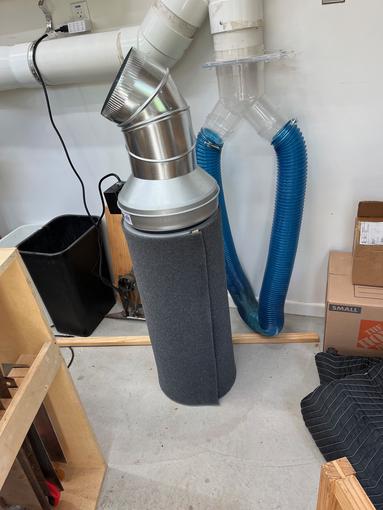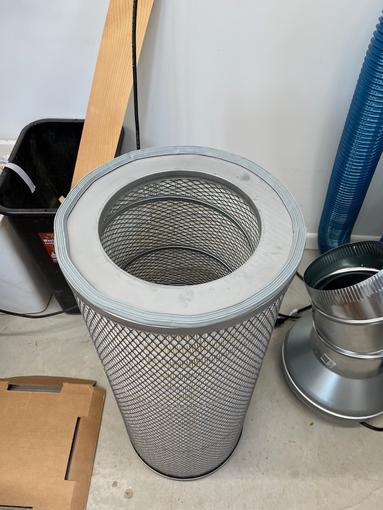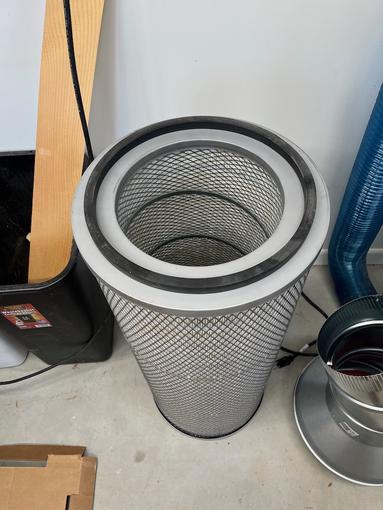This is my implementation of the air cleaner designed by Bill Pentz.
Overview
An air cleaner is the very last step in improving workshop air quality. First implement dust collection at your machines. Then clean up all the dust in your shop. Finally use an air cleaner. Read more
My rendition of Pentz’s design:

Air is sucked through the filter and blown out the top. Placing the filter on the floor is good because gravity naturally pulls the dust down. The adjustable elbow on top directs the air, causing more circulation.
I assembled it from these parts:
- Clone of a Clark NF20011 filter
- FanTech FG8 8" Centrifugal Inline Fan, which also required a power cord and 3/8" cable clamp
- EPDM Weatherstripping
- 8" adjustable elbow
- 30 PPI 1/4" Speaker Foam
- BN-LINK Indoor Countdown Timer
- Self-adhesive velco
(These are not affiliate links and I receive no compensation for this website.)
First I attached the cord to the fan because the fan I chose doesn’t come with one.
Then I applied weatherstripping to the bottom of the filter:

I set the filter, weatherstripping down, on the concrete floor.
The top of the filter comes with a gasket.

I set the fan on the gasket and the HVAC adjustable elbow on the fan.
The speaker foam is a prefilter. I don’t yet know if it is helpful. I cut the foam to size and wrapped it around the filter. I applied velco to both sides of the seam so I can remove the prefilter and wash it. The self-adhesive velco doesn’t stick well to the foam, so I will be looking for another option.
The sound level is a reasonble 66 dB From about 4 feet as measured by the NIOSH Sound Level App. It sounds like our new car on the highway. Not loud, but you have to turn the radio up a little.
The airflow is about 375 CFM measured using a Testo 405i hot wire anemometer, passing it across 4 equidistant diameters of the outlet.
Most importantly, it does clean the air. Using my particle counter, it will take the air in my 9x19 workshop to a PM2.5 of zero in just a few minutes. Generally I run it for about 30 minutes and after that the PM2.5 will stay close to zero.
How I Chose a Filter
Pentz recommends a Wynn 9L300NANOEXT, which is a MERV 15 filter with 300 sqft of filter media. This filter traps dust on the outside, just like what we want.
I chose a similar, but significantly cheaper Clark NF20011 filter from IndustrialCartridgeFilters.com. This filter is also MERV 15 and has 260 sqft of filter media.
Nearly all industrial filters are designed to have the dirty air on the outside and the clean air on the inside. This video explains how they work. In the original intended use for the filter, a blower pulls clean air through the inside of the filter, so the outside of the filter catches the dust. Then the industrial dust collector periodically sends a pulse of air from the inside, which pushes the caked dust off the filter and into the collection bin below.
The confusion is that in most home woodworking applications, such as single-stage canister collectors and cyclones, the dirty air is on the inside of the filter and the clean air is on the outside. Wynn Environmental sells to a lot of hobby woodworkers. Most filters they sell to woodworkers are designed to have dirty air on the inside, so they describe the 9L300NANOEXT as “reversed,” but actually it is standard flow for the rest of the industry. If you order from IndustrialCartridgeFilters.com, the standard air flow will be dirty air on the outside, clean on the inside, which is exactly what we want for the air cleaner. (BTW, any filter IndustrialCartridgeFilters.com sells can have the media reversed; you just have to call instead of using the website.)
I found the filter by using Filter Junkie and clicking “filter by dimensions.” The filter I chose is round, 12.75" in diameter, no flange, open both ends, and 30" long. I ordered from IndustrialCartridgeFilters.com because they gave more specifications for the filter I was actually ordering.
These industrial replacement filter companies, other than Wynn Environmental, are not setup to sell to consumers. See this comment from the owner of DamnFilters.com. They want companies that buy pallets of filters, so be polite and efficient with your order of one. They won’t help you pick a filter, but if you have the model number you want, you can order it. If you want help picking a filter, Wynn Environmental is your best bet.
The filter I chose, NF20011, automatically comes with nanofiber media (the NF prefix) rated at MERV 15. That seems like the best choice because MERV 16 filters are not readily available and HEPA filters cannot be cleaned.
How I Chose a Fan
There are 3 basic types of inline duct fans, axial, centrifugal, and mixed mode. An axial fan is probably what you think of as a “fan.” It has a propeller like a box or desk fan. Axial fans are inexpensive and move free air well, but cannot pull very much static pressure, so are inappropriate for duct work or pulling air through a filter. A centrifugal fan you might recognize as a squirrel cage fan. It slings air sideways, 90 degrees to the inlet and is needed for systems with duct work. A mixed mode fan is a combination of the two.
In this application you want a centrifugal fan so the air cleaner continues to work as the filter loads.
Pentz recommended an iPower GLFANXINLINE8 8 Inch Inline Duct Fan. This is an inexpensive centrifugal fan that includes a cord, so the total cost is about 1/3 the FanTech FG8 that I chose. I read several reviews that said the iPower fan failed after a few months. I am tired of buying cheap products that end up in the landfill. The FanTech fan came with a five year warranty, so spending more was worth it to me.
The FanTech FG8 claims 461 CFM at zero static pressure. The iPower fan does not publish a fan curve, but claims 750 CFM.
Other fans I considered:
-
Vents TT 200 - This mixed mode fan claims 440 CFM at 0" pressure, but at 1" of pressure only produces 34 CFM. The FanTech FG8 centrifugal fan produces 191 CFM at 1" of pressure, so using a mixed mode fan may lose significant airflow as the filter loads.
-
FanTech FG8XL - This is the big brother to the FG8. It claims 502 CFM at 0" pressure and 313 CFM at 1" of pressure. It is more expensive than the FG8 I chose. I didn’t think I needed the extra power (and noise).
-
Vivosun 8" Fan - Another inexpensive fan that claims 740 CFM with no fan curve. I read several reports of failure of this fan, so I avoided it, but it might work fine.
-
Vents VK 200 - This fan includes a fan curve and I think is about the same performance as the FG8XL. Vents is located in Ukraine, so is almost certainly impacted by the Russian invasion. You could order this fan as a political statement.
Remember what no matter what the rating of the fan says, the same laws of physics apply to them all. The fans that claim 750 CFM are exaggerating.
Alternatives
Here are some alternative solutions I considered.
Axiom Stratus is a commercialized version of the Pentz air cleaner. They do not publish the size of the filter media, but the photos do not show many folds in the filter media. I read reviews that this unit is very loud so I ruled it out.
I also considered a Corsi-Rosenthal Box made from furnace filters and a box fan. I was concerned the axial fan would not continue to pull air as the filters load.
Box in the sky. Rikon, Jet, Powermatic, Wen, and probably others, sell workshop air cleaners which are rectangular boxes you hang from the ceiling. I opted for the Pentz design because it has much more filter area. Also the Pentz design sits on the floor and blows up. The dust will tend to fall down and I believe the air currents up mix the air better.
Using the Air Cleaner at Home
After I built the air cleaner, we got excited about it and tried it out inside the house to see if it would help with my wife’s allergies. It did. However, we also found that just running the fan in the HVAC with a good furnace filter had the same effect. Running the HVAC fan is quieter, free, and takes up less space.
If the HVAC isn’t doing it for you, I would consider a purpose-built home air purifier. Many of those units have airflow equivalent to the unit I built. They are also in a more home-friendly package and price. I don’t think they work well in the workshop because the filters are much smaller, so would probably load quickly. They also tend to use HEPA filters, which cannot be cleaned, only replaced.
